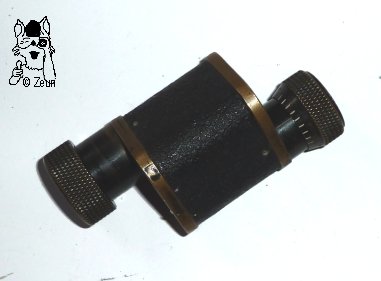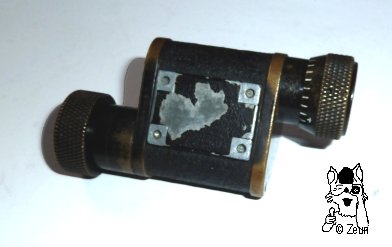Carl Zeiss St. Petersburg 5x15
| Das 5x15 Monokular von Carl Zeiss St. Petersburg dürfte wie das Carl Zeiss 4x (Fussartellerie) oder das Carl Zeiss 4x20 M.Blink ein Visier für Peil- oder Signalgeräte sein. Es gibt eine Strichplatte mit Fadenkreuz mit vertikaler und horizontaler Strichteilung, aber ohne Beschriftung. Das Messinggehäuse ist mit Rauhlack ummantelt, die Deckel schwarz lackiert. Die komplett umlaufende Dioptrienskala ist lediglich mit "0", + und - beschriftet. Am geriffelten Fokussierungsring gibt es keine weitere Augenmuschel. Eine weitere Fokussierung ist am Objektivtubus möglich. Unten am Gehäuse ist eine Montageplatte mit vier Schraublöchern. Zur Prismenjustierung gibt es am Gehäuse je kurzer Seite ein Schraubloch. Der untere Deckel ist mit dem Zeiss-Linsenlogo und "Carl Zeiss St. Petersburg" in kyrillisch und "1911 No.67" mit Silberlot beschriftet. Das Monokular dürfte also von 1911 stammen. Der obere Deckel hat ebenfalls eine kyrillsche Beschriftung mit Abkürzungen, deren Bedeutung sich noch nicht eindeutig übersetzen ließen. Evtl. wird die Vergrößerung mit 6fach angegeben (tatsächliche Vergrößerung 5x), die Strichplattenteilung mit 1/200 bezeichnet und das Sehfeld als solches oder der Strichteilung mit 17 Min. angegeben. An der Objektivseite gibt es die militärische Deckelrandnummer 258507. | The 5x15 monocular by Carl Zeiss St. Petersburg could be a gun sight or aiming sight for an aiming circle or signalling apparatus like the Carl Zeiss 4x (Fussartellerie) or the Carl Zeiss 4x20 M.Blink. There is a reticle with cross-haris and vertical as well as horizontal division lines, but without numbers. The brass body is covered with a rough paint, the cover plates are painted black. The full dioptre scale is only marked wit "0", + and -. There is no extra eyecup at the knurled focusing ring. Another focusing ring is at the objective tube. At the bottom of the housing is a mounting plate with four screw holes. There is one screw hole at each shorter side of the body for adjusting the prisms. The lower cover is inscribed with the Zeiss lens logo and "Carl Zeiss St. Petersburg" in Cyrillic letters as well as "1911 No.67", all done with silver solder. So, the sight dates from 1911. The upper cover bears Cyrillic script, too. Some abbreviations there are still not translated in their full meaning, but probably denote the magnification being 6 times (actually being 5x), the reticle having a 1/200 division, and the field of view or the division line distance being 17 minutes. The military number 258507 is stamped into the objective cover rim. |




| Das Visier ist 148g schwer. Es ist 80-89mm lang und der Korpus 34x34mm (längste Seite 40mm) breit und 39mm lang. Der Okulartubus ist 19mm, der Objektivtubus 21mm im Durchmesser. Der Okularfokussierungsring ist 33,5mm, der Objektivfokussierungsring 35mm im Durchmesser. | The sight weighs 148g. It is 80-89mm long and the body measures 34x34mm (longest side 40mm) in width and 39mm in height. The ocular tube is 19mm, the objective tube is 21mm im diameter. The ocular focusing ring is 33.5mm, the objective focusing ring 35mm in diameter. |
Fotos: Zeun

